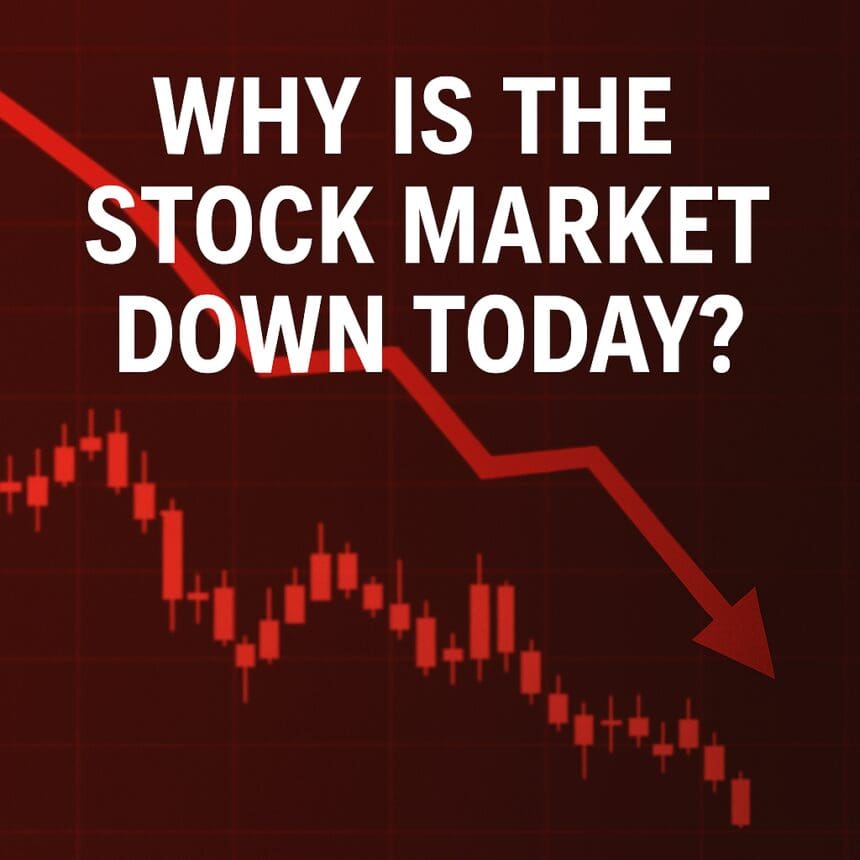In this article, I will analyze the Why Is the Stock Market Down Today. There are a variety of influences such as economic indicators, geopolitical conflicts, and the attitude of the investors which has caused the main indices to drop.
With a grasp of these factors, it is easier to evaluate the state of the market at any given point in time and its likely direction in the future. Follow us as we analyze today’s stock market activity.
What is Stock Market?
The share market refers to an economic market where individuals trade stocks issued by publicly traded companies. The marketplace allows businesses to generate revenue and individuals to invest in large scale companies for possible financial gains.

As for other markets, the prices of stocks vary according to availability and require products, economic situations, interest payout ratios, and international situations. The United States houses the New York Stock Exchange and the Nasdaq stock markets.
At the same time investors hope to grow their assets stock markets assist companies to expan hence both the economy and companies develop.
Why Is the Stock Market Down Today?
A few factors contributing to the stock market’s decline include:
Indian stock markets commenced the financial year 2025-26 (FY26) with a significant dip on the first trading day. Major indices recorded a steep fall, with the BSE Sensex plunging 1,390.41 points (1.80%) and closing at 76,024.51 and Nifty50 declining 353.65 points (1.50%) to settle at 23,165.70. Profit booking from IT and banking stocks, which were the largest losers in the market, brought down the market as a whole.

Further, according to ICICI Securities, policy shifts in the US concerning tariffs have led to ambiguity which affects client decisions and could slow recovery in discretionary spending.
Kotak Securities, however, noted that concerns over asset quality remain less dire than anticipated due to subdued selling pressure, with signs of recovery in the unsecured loan segments.
Private lenders took significant blows, with HDFC Bank and Axis Bank falling 2.3% each, with these banks now joining the rest for heavy selling pressure. These banks, which had been benefitting earlier due to a flight-to-safety trend, now seem to have suffered.
Among financial stocks, Bajaj Finance and Bajaj Finserv were down 2%, while Sun Pharma lost 1.76%, finally closing at ₹1,704 emerging as one the dismal performers Sensex stocks.
Uncertainty Over US Tariff Policies
The Consequence of Trump’s Tariff Strategies
The concerns associated with Trump’s tariffs policies were not helping people’s mood at the forefront of the investors’ market. Trump has proclaimed April 2 as “The Day of Freedom”, which marks the beginning of reciprocal tariffs on numerous countries that increases the tension on Indian pharmaceuticals’ profit margin.
In a recent report, Nomura noted that in advance of the announcement, pharmaceutical stocks have already started to move downward in value as investors became fearful of generic drug manufacturers’ inability to shift the burden of expensive costs onto consumers.
Geojit Investments’ VK Vijayakumar highlighted that world markets are focused on how the announcement of the tariffs will actually play out.
“The markets may move lower as we anticipate more stringent tariffs,” Vijayakumar said. “At this stage, people want to understand clearer plans and patterns.”
Trends of Domestic and Foreign Investments
On March 28, Foreign Institutional Investors (FIIs) went on with the selling spree, stocking up ₹4,352 crore worth of equities. On the other hand, Domestic Institutional Investors (DIIs) purchased for the second straight day with their purchases totaling ₹7,646 crore.
Ample Concerns Regarding Supply Make Oil Prices Skyrocket
Crude oil now trades for around 2% higher than previous, making a five-week high. This spike comes with issues regarding possible supply constraints. Further volatility in the energy market may arise if the US puts more sanctions on Russia or further escalates military conflict with Iran.
- Brent crude markets were up by $1.11 (1.5%), and is currently valued at $74.74 per barrel.
- The West Texas Intermediate (WTI crude oil markets were gainfully active, rising by $2.12 (3.1%) bringing it’s current value to $71.48 per barrel.
The Decline of IT Stocks and the Rupee’s Weakness
The IT stocks also came under selling pressure with Infosys sticking out as the worst performer on the Sensex who is down by almost 2.86% and is currently priced at ₹1,525. Other big names from the technology sector such as HCL Tech, TCS, and Tech Mahindra suffered losses up to 2.4%.
On the other hand, the Indian rupee performed poorly losing 32 paise to put it’s current value at 85.47 per US dollar. This indicates mark of caution from the investors. Simultaneously, the dollar index, that tallies the greenback against a conglomerate of six crucial international currencies slumped by 0.14% to 104.04.
The Market Trend Forecast
Due to the lack of clarity around US tariff policies, it is sensible to predict further fluctuations in the market within the next few days. Investors are most definitely going to be counseled to closely observe further advancements to understand their repercussions on Global as well as Indian equities.
Conclusion
Today’s stock market decline can be explained by a mix of economic anxiety around the globe, distinct policy changes, some challenges, and the investors’ emotions.
Important moving parts include tariffs in the US, increased oil prices, foreign investors cashing in, and the lackluster performance of the banking and IT sectors.
There might be turbulence in the near future but market movements will depend largely on policymaker actions, economic statistics, and earnings figures from companies.
It will be tough for investors at this stage since there is uncertainty regarding global economic growth and policies, thus making it crucial for them to adjust their expectations accordingly.









